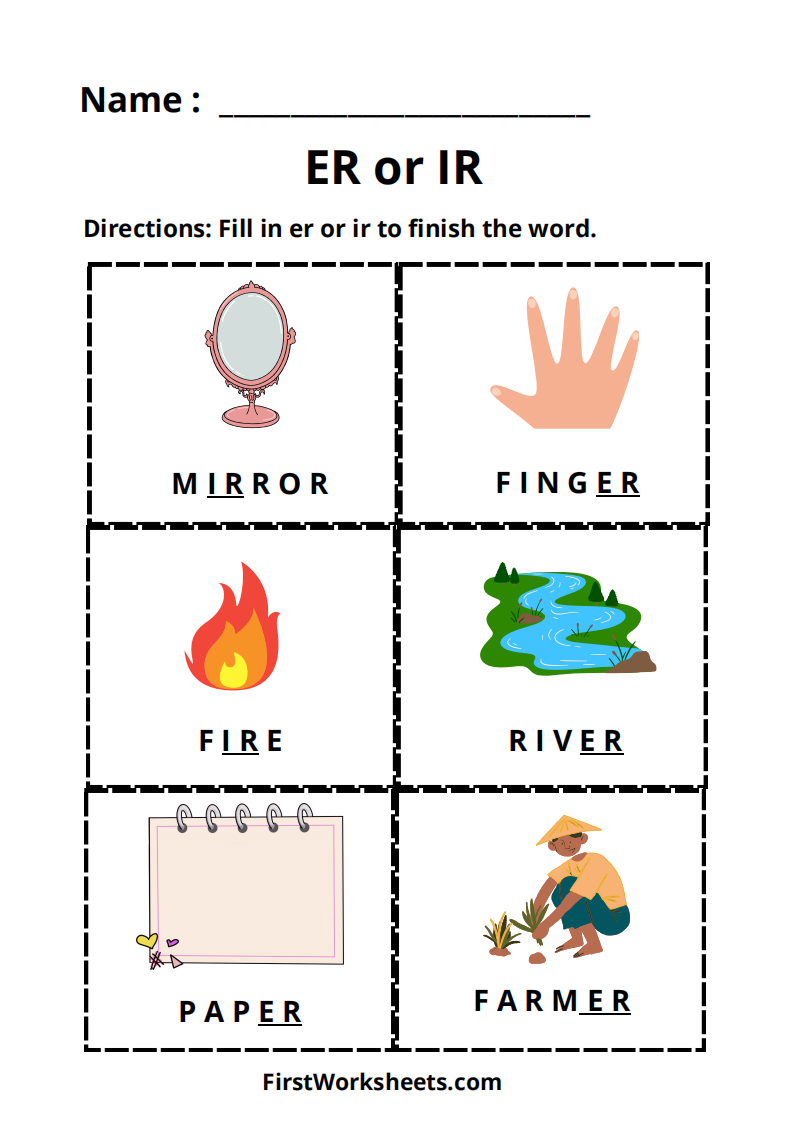R-controlled Vowels Worksheets
R-controlled vowels worksheets are educational resources designed to help students understand and practice a specific phonics rule related to vowels and the “r” sound. In English, when a vowel is followed by the letter “r,” it changes the way the vowel is pronounced, which is why this concept is commonly referred to as “R-controlled” vowels or “Bossy R.” These worksheets are often used in early elementary education and ESL learning to improve students’ reading and pronunciation skills by focusing on the unique sounds produced by R-controlled vowel combinations. Here’s a detailed breakdown of what these worksheets typically include and how they can be used effectively in learning.
Focus on the R-Controlled Vowel Combinations
R-controlled vowels are vowel sounds that change because of the influence of the “r.” The most common R-controlled vowel combinations include:
- “ar” (e.g., “car,” “star”)
- “er” (e.g., “her,” “better”)
- “ir” (e.g., “bird,” “stir”)
- “or” (e.g., “fork,” “born”)
- “ur” (e.g., “burn,” “fur”)
Each of these combinations has a distinct sound. Worksheets often categorize words by their R-controlled vowel type, allowing students to practice recognizing and pronouncing each combination separately.
Types of Activities Found in R-Controlled Vowels Worksheets
Worksheets on R-controlled vowels include various activities to reinforce learning through different approaches:
- Word Sorting: Students may be asked to sort a list of words into categories based on the R-controlled vowel pattern. For example, they would place words with “ar” in one column, “or” in another, and so on.
- Fill-in-the-Blank Exercises: Students fill in missing R-controlled vowels in words. This reinforces their understanding of how these vowels interact with “r” to create specific sounds.
- Matching Words and Pictures: Especially useful for younger students, this activity has students match words with pictures representing those words. For instance, matching the word “car” with an image of a car.
- Spelling Practice: Spelling exercises help students understand the unique spellings of words with R-controlled vowels and reinforce the pronunciation rules.
- Sentence Completion: Worksheets may include sentences with blanks where R-controlled vowel words are missing. This helps students see how these words function in the context of sentences.
- Reading Practice: Some worksheets include short reading passages containing multiple R-controlled vowels. This provides students with practice recognizing and pronouncing these words within larger text.
Visual Cues and Phonetic Guides
Many R-controlled vowel worksheets include visual aids, such as pictures or phonetic spellings, to help students associate sounds with the written form. For example:
- Phonetic Spelling: Some worksheets include phonetic transcriptions (like /ɑr/ for “ar” in “car”) to guide pronunciation.
- Picture Cues: Visual images of objects corresponding to R-controlled words help reinforce meaning and sound association, especially for younger learners or visual learners.
Reinforcement Through Games and Interactive Worksheets
To make learning engaging, many worksheets incorporate game-like activities:
- Crossword and Word Searches: These activities involve finding R-controlled vowel words hidden within a grid.
- Word Bingo: A fun way for students to practice recognizing and reading R-controlled vowel words.
- Puzzles: Activities like connecting matching words or completing a puzzle can reinforce memory and pattern recognition.
Benefits of Using R-Controlled Vowel Worksheets
R-controlled vowels are tricky for learners because they don’t follow the standard vowel sounds students have learned. These worksheets:
- Improve phonemic awareness by highlighting how vowel sounds can change.
- Help English learners and younger students to pronounce words more accurately.
- Provide a structured method for mastering an essential phonics concept, laying the foundation for more advanced reading skills.
Suggested Activities Beyond Worksheets
Teachers or parents can extend learning through activities like:
- Reading Aloud: Encouraging students to read aloud words or sentences with R-controlled vowels helps improve fluency.
- Spelling Games: Practicing spelling with R-controlled vowels can solidify memory and reinforce pronunciation.
- Craft and Art Activities: Create visual arts projects where students decorate words like “car” or “star” to further associate the words with sounds.
Using R-controlled vowel worksheets in these ways can make phonics learning enjoyable, engaging, and highly effective for students working on mastering this particular sound pattern in English.





